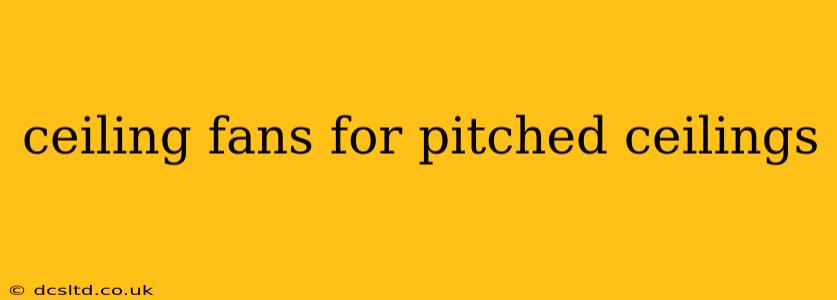Installing a ceiling fan in a room with a pitched ceiling can seem daunting, but with the right knowledge and approach, it's entirely achievable. This comprehensive guide will walk you through everything you need to know, from choosing the right fan to ensuring safe and effective installation. We'll even address common questions and concerns.
What are the Challenges of Installing a Ceiling Fan on a Pitched Ceiling?
Pitched ceilings present unique challenges compared to flat ceilings. The angle of the ceiling necessitates specialized mounting hardware and often requires more precise measurements and installation techniques. Standard ceiling fan kits aren't designed for this angle, leading to potential instability and safety risks if not handled correctly. The steeper the pitch, the more complex the installation becomes.
Types of Ceiling Fans Suitable for Pitched Ceilings
Not all ceiling fans are created equal. When dealing with a pitched ceiling, you'll need a fan specifically designed for angled ceilings. These fans usually come with:
- Adjustable Mounting Brackets: These allow you to adjust the fan's position to align perfectly with the ceiling's angle, ensuring stability and proper airflow.
- Specialized Mounting Hardware: This hardware is stronger and more robust than standard mounting systems, capable of securely supporting the fan's weight on an angled surface.
- Longer Downrods (Often Included): Longer downrods are crucial to maintain adequate clearance between the fan blades and the ceiling. They also help position the fan at the optimal height for efficient air circulation.
How to Choose the Right Ceiling Fan for a Pitched Ceiling
Choosing the right fan involves considering several factors beyond just its suitability for angled ceilings:
- Room Size: The fan's blade size and motor power should match the room's dimensions to ensure effective air circulation. Larger rooms require larger, more powerful fans.
- Ceiling Height: Even with a longer downrod, the overall height of the fan needs to be considered to avoid obstructing doorways or other fixtures.
- Style: Just because you have a pitched ceiling doesn't mean you have to compromise on style. Many manufacturers offer aesthetically pleasing fans designed for angled ceilings.
- Features: Consider features such as reversible airflow (for summer and winter use), remote control operation, and lighting options.
What is the best type of ceiling fan for a sloped ceiling?
The best type is one specifically designed and marketed for sloped or vaulted ceilings. Look for features like adjustable mounting brackets, longer downrods (often included), and robust mounting hardware designed to handle the angle and weight of the fan securely. Don't attempt to use a standard ceiling fan on a sloped ceiling – it’s unsafe and ineffective.
How do you install a ceiling fan on a sloped ceiling?
Installing a ceiling fan on a sloped ceiling requires careful measurement and precise installation. It's highly recommended to consult the manufacturer's instructions for your specific fan model. Generally, it involves:
- Careful Measurement: Accurately measure the angle of the ceiling and the distance from the ceiling joist to determine the correct placement of the mounting bracket.
- Secure Mounting: Use the specialized mounting hardware provided with the fan to securely attach the mounting bracket to the ceiling joist.
- Wiring: Carefully connect the fan's wiring to the house's electrical wiring according to the manufacturer's instructions and local electrical codes. If unsure, consult a qualified electrician.
- Attaching the Fan: Attach the fan motor and blades to the mounting bracket, ensuring everything is securely fastened.
- Testing: Once installed, test the fan to ensure it operates correctly and safely.
Can you use a regular ceiling fan on a sloped ceiling?
No, you should never use a regular ceiling fan on a sloped ceiling. Regular fans are not designed to handle the angle and may not be securely mounted, creating a significant safety hazard. The fan could fall, potentially causing damage or injury. Always use a fan specifically designed for sloped ceilings.
What is the minimum slope for a sloped ceiling fan?
There isn't a universally defined minimum slope. However, any ceiling with a significant angle—beyond a slight incline—should use a fan designed for sloped ceilings. Manufacturers may provide recommendations in their product specifications, but if you are unsure, it's always best to err on the side of caution and use a sloped ceiling fan.
Conclusion
Installing a ceiling fan in a room with a pitched ceiling is achievable with the right fan and careful installation. By following these guidelines and choosing a fan specifically designed for sloped ceilings, you can enjoy the benefits of improved air circulation and enhanced comfort without compromising safety. Remember, if you are uncomfortable with any aspect of the installation, it’s always best to consult a qualified electrician.
